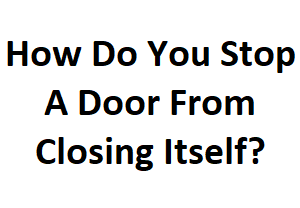Have you ever experienced the frustration of a door that insists on closing itself, seemingly defying your attempts to keep it open? Whether it’s a pesky interior door that keeps swinging shut or an outdoor door that slams with the slightest breeze, this common household annoyance can be easily remedied with some simple solutions. In this blog post, we will explore several practical methods to stop a door from closing itself, ensuring that you can move freely without constantly battling a stubborn door.
Door Stoppers
One of the most straightforward and effective solutions to prevent a door from closing itself is to use a door stopper. Door stoppers come in various designs, including wedge-shaped stoppers, magnetic stoppers, and floor-mounted stoppers. Wedge-shaped stoppers can be easily placed under the door to hold it open, while magnetic stoppers are attached to the door and the wall or floor, preventing it from closing too far. Floor-mounted stoppers can be installed on the base of the door and serve as a physical barrier to keep the door open.
Door Closers
If you want a more automated solution, consider installing a door closer. Door closers are mechanisms that automatically close the door after it has been opened. However, some door closers come with adjustable settings, allowing you to control the closing force. By adjusting the settings appropriately, you can prevent the door from closing too quickly or forcefully, giving you ample time to pass through the doorway.
Hinge Adjustment
Sometimes, the cause of a self-closing door lies in the hinges. If the hinges are misaligned or loose, the door may not stay in the desired position. To address this issue, you can tighten the screws on the hinges, which will help stabilize the door. Additionally, try lubricating the hinges with a silicone-based lubricant to reduce friction and facilitate smoother door movement.
Use Door Stays or Door Chains
For external doors, such as screen doors or storm doors, door stays or door chains can be a helpful solution. Door stays are devices that can be attached to the door and frame, allowing you to fix the door at a specific angle, preventing it from closing on its own. Door chains, on the other hand, permit limited movement of the door, ensuring it stays partially open without swinging shut.
Weighing Down the Door
For interior doors that tend to close on their own due to air circulation or uneven floors, adding weight to the door can provide a quick fix. You can attach a doorstopper with a weighty base to the bottom of the door or attach a sandbag or other heavy object to the door’s inside edge. This added weight will make it less likely for the door to close by itself.
Tips for Choosing the Right Solution
While the methods mentioned above can effectively stop a door from closing itself, it’s essential to consider a few factors before settling on a specific solution:
- Door Type: The type of door you are dealing with will influence the most suitable method. For instance, interior doors may require different approaches compared to external doors like screen doors or storm doors.
- Aesthetics: Some solutions, such as door stoppers and door chains, might not be visually appealing to everyone. If aesthetics are crucial, explore options like concealed door closers or door stays that blend seamlessly with the door and frame.
- Budget: The cost of the solution is another aspect to consider. Door stoppers and door wedges are generally inexpensive, while door closers and other automated solutions may require a more substantial investment.
- Ease of Installation: If you prefer a DIY approach, choose solutions that are easy to install without professional help. Some options, like adjusting hinges or installing door stoppers, are relatively straightforward tasks for most homeowners.
- Safety Considerations: Ensure that the chosen method does not create any safety hazards. For example, a door stopper with a heavy base should not obstruct foot traffic or pose a tripping risk.
Maintenance and Regular Checks
Once you’ve implemented the solution to stop the door from closing itself, it’s essential to perform regular maintenance checks to ensure everything is in proper working condition. Here are a few maintenance tips:
- Lubricate Hinges: Periodically lubricate the door hinges to keep the movement smooth and prevent squeaking or sticking.
- Check Door Closers: If you’ve installed door closers, inspect them regularly for any signs of wear or damage. Adjust the settings as needed to maintain the desired closing force.
- Test Door Stoppers: Test the door stoppers or door stays to ensure they are functioning correctly and not losing their grip over time.
- Inspect for Damage: Routinely inspect the door and its components for any signs of damage. Promptly address any issues you discover to prevent further complications.
Conclusion
Stopping a door from closing itself is a relatively simple problem to solve, thanks to the variety of effective solutions available. Whether you opt for door stoppers, door closers, hinge adjustments, door stays, or adding weight to the door, each method offers its unique advantages and can be tailored to suit different door types and user preferences.
Remember to consider factors like aesthetics, budget, ease of installation, and safety when choosing the most suitable solution for your needs. Additionally, regular maintenance checks will help ensure that the chosen method continues to function optimally, keeping your doors conveniently open and enhancing your overall living experience.
So, the next time you encounter the aggravation of a self-closing door, don’t fret! Armed with the knowledge from this blog post, you can confidently implement the right solution and bid farewell to the annoyance of constantly battling with a door that refuses to stay open. Happy door-taming!
